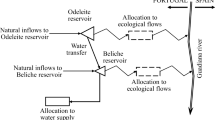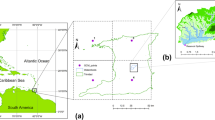Abstract
Reservoirs are key components of water infrastructure that serve many functions (water supply, hydropower generation, flood control, recreation, ecosystem services, etc.). Climate change affects the hydrology of the tributary areas to reservoirs, which may profoundly impact their operation and possibly the reservoirs’ water quality, among which the temperature gradient and the total dissolved solids (TDS) are key qualitative characteristics of reservoirs, especially those with irrigation function. This study examines water-quality changes in the Aidoghmoush reservoir (East Azerbaijan-Iran) under climate-change conditions in the period 2026–2039. The temperature and precipitation climate variables are calculated by the HadCM3 model driven by emission scenario A2 in the baseline period (1987–2000), and these variables are then projected over the future period (2026–2039). The average annual runoff under climate-change conditions is simulated by the IHACRES model. The results show the future average annual runoff would decrease by about 1% compared to the baseline conditions. The CE-QUAL-W2 model is employed to simulate the reservoir water quality. It is predicted the surface air temperature would increase by 1.3 °C under the climate-change scenario compared to the baseline condition, and the temperatures of the reservoir’s surface- and bottom-waters would increase by 1.19 and 1.24 °C, respectively. The average TDS near the reservoir surface would increase by 44.5 g/m3 (4.3%) relative to baseline TDS. The TDS near the reservoir surface are projected to be highest in autumn and winter for baseline and future conditions. This research shows that changes due to climate change are potentially severe, and presents a methodology that could assist managers and planners to find optimal strategies of reservoir operation to cope with changes in thermal stratification and TDS. This paper results identify the reservoir levels from which to withdraw water with the best water-quality characteristics.












Similar content being viewed by others
References
Amirkhani M, Bozorg-Haddad O, Fallah-Mehdipour E, Loáiciga HA (2016) Multiobjective reservoir operation for water quality optimization. J Irrig Drain Eng 142(12). https://doi.org/10.1061/%28ASCE%29IR.1943-4774.0001105
Ashofteh P-S, Bozorg-Haddad O, Mariño MA (2013) Scenario assessment of streamflow simulation and its transition probability in future periods under climate change. Water Resour Manag 27(1):255–274. https://doi.org/10.1007/s11269-012-0182-2
Ashofteh P-S, Bozorg-Haddad O, Loáiciga HA (2017a) Development of adaptive strategies for irrigation water demand management under climate change. J Irrig Drain Eng 143(2). https://doi.org/10.1061/(ASCE)IR.1943-4774.0001123
Ashofteh P-S, Bozorg-Haddad O, Loáiciga HA (2017b) Logical genetic programming (LGP) development for irrigation water supply hedging under climate-change conditions. Irrig Drain 66(4):530–541. https://doi.org/10.1002/ird.2144
Butcher JB, Nover D, Johnson TE, Clark CM (2015) Sensitivity of lake thermal and mixing dynamics to climate change. Clim Chang 129(1–2):295–305. https://doi.org/10.1007/s10584-015-1326-1
Chung SW, Gu RR (2009) Prediction of the fate and transport processes of atrazine in a reservoir. Environ Manag 44(1):46–61. https://doi.org/10.1007/s00267-009-9312-x
Cole, T. M. and S. A. Wells (2006). “CE-QUAL-W2: A two-dimensional, laterally averaged, Hydrodynamic and Water Quality Model, Version 3.5,” Instruction Report EL-06-1, US Army Engineering and Research Development Center, Vicksburg, Ms
Debele B, Srinivasan R, Parlange J-Y (2008) Coupling upland watershed and downstream waterbody hydrodynamic and water quality models (SWAT and CE-QUAL-W2) for better water resources management in complex river basins. Environ Model Assess 13(1):135–153. https://doi.org/10.1007/s10666-006-9075-1
Heidarzadeh and Motiey Nejad (2017) simulated the TDS by CE-QUAL-W2 in two scenarios of with and without sedimentation in normal, dry, and wet periods of inflow for Shahriyar reservoir, Iran. With the outflow TDS, there was no limitation to use of reservoir water for agricultural purposes based on FAO irrigation guidelines for both scenarios
IPCC-TGCIA (Intergovernmental Panel on Climate Change, Task Group on Scenarios for Climate Impact Assessment). (1999). Guideline on the use of scenario date for climate impact and adaptation assessment. Version 1, T .R. Carter, M. Hullme, and M. Lal, eds., Intergovernmental Panel on Climate Change, Task Group on Scenarios for Climate Impact Assessment,69
IPCC-DDC. (1988). “Data distribution center.” < http: / ipcc-ddccru.uea.ac.uk/ >
Lee HW, Kim EJ, Park SS, Choi JH (2012) Effects of climate change on the thermal structure of lakes in the asian monsoon area. Clim Chang 112(3–4):859–880. https://doi.org/10.1007/s10584-011-0233-3
Liu W-C, Chen W-B, Kimura N (2009) Impact of phosphorus load reduction on water quality in a stratified reservoir-eutrophication modeling study. Environ Monit Assess 159(1–4):393–406. https://doi.org/10.1007/s10661-008-0637-3
Liu WC, Chen WB (2013) Modeling hydrothermal, suspended solids transport and residence time in a deep reservoir. Int J Environ Sci Technol 10(2):251–260. https://doi.org/10.1007/s13762-012-0147-2
Peng H, Zheng X, Chen L, Wei Y (2016) Analysis of numerical simulation and influencing factors of seasonal manganese pollution in reservoirs. Environ Sci Pollut Res 23(14):14362–14372. https://doi.org/10.1007/s11356-016-6380-3
Sabeti, R., Jamali, S., and Hajikandi-Jamali, H. (2017) “Simulation of thermal stratification and salinity using the Ce-Qual-W2 model (case study: mamloo dam)”. Engineering, Technology & Applied Science Research, 1664–1669
Shokri A, Bozorg-Haddad O, Mariño MA (2014) Multi-objective quantity–quality reservoir operation in sudden pollution. Water Resour Manag 28(2):567–586
Soleimani S, Bozorg-Haddad O, Saadatpour M, Loáiciga HA (2016) Optimal selective withdrawal rules using a coupled data mining model and genetic algorithm. J Water Resour Plan Manag 142(12). https://doi.org/10.1061/%28ASCE%29WR.1943-5452.0000717
Vaighan AA, Talebbeydokhti N, Massah Bavani A (2017) Assessing the impacts of climate and land use change on streamflow, water quality and suspended sediment in the Kor River basin, southwest of Iran. Environ Earth Sci 76:543. https://doi.org/10.1007/s12665-017-6880-6
Yazdi J, Moridi A (2017) Interactive reservoir-watershed modeling framework for integrated water quality management. Water Resour Manag 31(7):2105–2125. https://doi.org/10.1007/s11269-017-1627-4
Author information
Authors and Affiliations
Corresponding author
Ethics declarations
Conflict of Interest
None.
Rights and permissions
About this article
Cite this article
Azadi, F., Ashofteh, PS. & Loáiciga, H.A. Reservoir Water-Quality Projections under Climate-Change Conditions. Water Resour Manage 33, 401–421 (2019). https://doi.org/10.1007/s11269-018-2109-z
Received:
Accepted:
Published:
Issue Date:
DOI: https://doi.org/10.1007/s11269-018-2109-z




